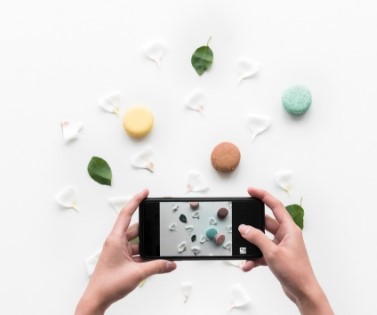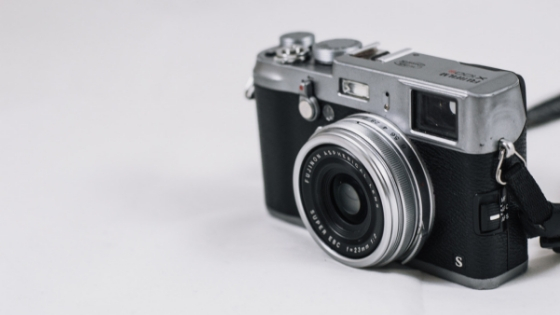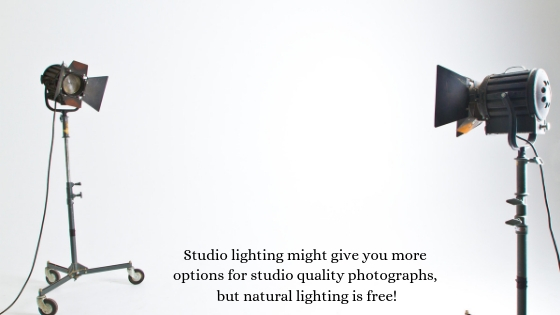Product Photography Tutorial
As you must already be aware to have clicked onto this post, visuals of the products you’re selling are a crucial converter.
Taking pictures of products online is often treated as a simple task, but you can’t just snap away and take any old photos – well you can, but you can’t do that and expect to make any sales.
You should be aiming to make up for the fact you’re not a physical retail store, and the fact your potential customers can’t see your products in real life.
Professional quality, highly attractive product photography can go a long way towards achieving this and of course, can win the order for you.
It should come at no surprise that 75% of eCommerce shoppers say product pictures are very influential when they’re deciding whether to buy a product online.

But for an eCommerce startup or a sole trader business, it might be the case that you aren’t particularly talented at photography and can’t afford a professional photographer.
This is part of the reason we get asked how to photograph products or how to take professional product photos so often.
Fear not, because all you need is a little bit of know-how and a couple of pretty cheap bits of kit.
We’re going to give you some DIY product photography tips, show you how to set up a product photo shoot and allow you to take compelling product photographs that will make a huge difference to the conversion rates of your product page.
Just settle in and we’ll start with the basics:

Equipment Needed for Product Photography
For professional photographers, their equipment is their livelihood.
Some of the best product photographers spend thousands upon thousands on their kit.
Luckily for you, starting out in product photography doesn’t require all of that.
We will try to keep this part as simple and concise as possible to avoid you spending money on things you simply don’t need and will provide tips on cheap product photography as we go on.
Let’s start with the obvious:
Best Camera Options for Product Photography
When deciding what the best camera for your website product photography might be, you should remember it’s completely unnecessary to have a top-of-the-range camera.
In fact, most modern smartphones are even up to the job.

It’s a common misconception that you need a professional quality camera to take high-quality product photos when in reality lighting, exposure, and your own eye for what looks good are much more important!
We will look more at how best to take pictures of products with a smartphone in a little bit, but first:
Camera Settings for Product Photography
While what we said above is true, and it’s possible to take impressively professional product photos with any camera these days, if you do have a professional camera with these settings options, you will want to make use of them to improve the results you can achieve.
If you’re using a more simple camera that doesn’t give you these options, you have nothing to worry about!
Just scroll past this section for more tips.
Otherwise, let me explain:
ISO:
ISO settings allow you to adjust how sensitive to light your camera sensor will be while shooting product photos.
The lower your ISO setting, the lower the sensitivity and therefore the longer it will take to snap a photo.
You may wish to increase the ISO at times to allow you to snap photos more quickly or achieve better results in low light conditions, but higher ISO also creates images with a more grainy look.
In the case of product photography, since movement and lighting aren’t an issue, it’s a good idea to use the lowest ISO possible at all times to keep your images smooth, well lit and grain-free.

A good method for figuring this out is to set up your camera on its tripod in the correct lighting and play with the ISO until you meet the sweet spot that makes your products look their best, but if you can’t tell, just go for the lowest setting.
Aperture:
The aperture essentially works like the pupil in the human eye, adapting to control the amount of light that passes through. It is measured in a range generally going from F1 to F22. The lower this number is, the more light is able to get to your camera lens, meaning your shutter lens will perform faster.
Because you’re using a tripod to take still images in fairly standardised light, shutter speed doesn’t really matter for product photos.
This means it’s better to keep your aperture set to the highest F number your camera allows, to catch your product in the sharpest focus possible.
Shutter Speed:
As mentioned above, it is best to maintain a low shutter speed when taking still product photos, to allow the aperture to absorb enough light to make the photos as sharp as possible.
However, you may have to increase the shutter speed a bit if you’re taking product photos with models, to account for their movements and minimise motion blur.

When combining ISO, aperture and shutter speed, you get a full picture of how your camera interacts with the light around it, so don’t be afraid to read up more on this if you need to.
Tripod:
When you have your shutter speed set low to take high-quality product photos, you won’t really be able to handhold the camera because of the extreme sensitivity to movement.
To mitigate this, and to allow you the freedom to move your products around freely while leaving your camera in a suitable position, a tripod is an absolute must.
Luckily, virtually any tripod will do the job of holding your camera still in one place, so there is no need to splash out on a specific one.

Ok, so you’ve figured out your camera’s settings (if necessary) and you’re ready to have a go?
The next step is to make sure your lighting is set up correctly:
Product Photography Lighting Tips
Lighting is the most important aspect of product photography.
You can have everything else set up perfectly and be a master photographer if you like, but if the lighting isn’t right, your photos won’t look good either, it’s as simple as that.
A lot of people wonder whether to make/purchase a light tent or use natural window light.
For the purpose of this guide, I’m going to stick to natural light for several reasons.
The most important reason being that this is a guide to professional quality product photography done cheap, and setting up a light tent is a costly and complex project that not only is far beyond the scope of this article but often costs more than simply hiring a professional photographer.

The other reason is that natural light usually means one light source, making managing your set up much simpler.
If you’re a small business and want to get the best quality images without breaking the bank, then window light should be more than enough.
You can get creative with managing natural light on a budget too, for example by draping white paper over the window if the light is too harsh, or using reflective surfaces on the opposite side of your products to soften shadows.
How to Take Product Pictures with a White Background
There is a range of product photography backdrops out there, but purpose-made ones tend to be more expensive than you need to pay at this juncture.

The best option for product photography on a white background is to buy a paper sweep.
These are not only typically very cheap, but they can be rolled down to replace your background if they get dirty or damaged over time.
If you want to go even cheaper just to get started and take some photos, poster board or large sheets of normal white paper can work pretty well too.
First, you want to set up your table.
Ideally, you want your light source (window or studio light) to be off to the side of your white background but otherwise as close as possible.
Another important tip that people often forget is to turn off/remove any other light sources in the room, no matter how small or faint they might as they will contaminate the lighting and have an unpredictable effect on your photos.
That means even the little red light on your TV and similar should be turned off or covered.
When using natural window light, you should also avoid direct sunlight onto your products or backdrop as that will give a washed out look.
Product Photography Setup
Once your table and light source are set up correctly, you can set up your products on the white background and get your camera set up on its tripod.
Outside of the camera settings mentioned above, you want to set your white balance to auto, your file size to the largest option possible and your quality setting to the highest pixel count possible.
This avoids any loss of quality and gives you the best possible source file to work from.
The chances that your first product photograph will turn out great is pretty slim. You will have to play around with the setting, change the direction of the light, move your reflectors around etc until you get the perfect angle and lighting.
If you have done some persona marketing while researching your products (and you really should!), keep your personas in mind while laying out your products onto the backdrop.
It might sound strange but there are often little tweaks you can make to apply directly to these personas, making the product look like it’s in a situation where it’s being used by them.
For example, if you’re taking photos of a product that often uses batteries, but your own version is rechargeable, and your customers keep asking you if this is the case? Put the charger in one of the photos.
These can be subtle ways to both increase sales and decrease customer service query volume.
It will take some time to find your best setup, but that’s really all there is to it!
How to Take Good Product Photos with a Smartphone

In all honesty, smartphone cameras are so advanced these days that very little changes here.
Your lighting and product backdrop setup will, of course, remain the same.
One major difference is that you will likely have much less control of your capture settings.
Since most modern smartphones have great cameras and automatically adapt to light, this isn’t a major problem and can still result in some great photos.
If this is too much of a problem for you, there are some advanced camera apps and even smartphone lens attachments and tripods out there that can go a long way towards alleviating the issue- some of which can give you full control over all the settings we mentioned above, so if you have access to something like that it can’t hurt at all.
Should I Hire a Photographer for My Website Products?
Honestly, the answer is no – the method we’ve shown you is so cheap and easy to carry out that it would be a waste of money.
With a little time and effort, you can be creating professional quality product photographs quicker than you’d probably expect.
You may wish to go this way, however, if you’re a sole trader with limited time.
Make sure you look for a photographer that specialises in product photos and has all of the correct setup already.
While this will be a lot more expensive than doing it yourself, it can be a load off your mind and leave you to focus on more important things.
In the same way, you may wish to get some of the greatest minds in the industry to boost your Amazon product rankings using our uniquely effective original method, allowing you to focus on other things while your profits grow.
If this is interesting to you, take a look at our case studies to see some of the results we have achieved from existing customers.
Otherwise, onward with the guide:
DIY Product Photography with Models
Shooting with models, for example, if the products you’re trying to sell are clothing or jewellery related items, can be slightly different since you aren’t simply shooting a still object.
Not only will you need to adjust your shutter speed to allow for movement, but you will likely want to use some props to create an atmosphere.
While white backgrounds can still be used, they are usually combined with photos of models in real-world locations too for maximum impact.
Professional photographers that are working with models will have stylists, hairdressers, makeup artists, and pre-planned looks.
While you don’t need to go that far in the early stages, you can’t really just plonk your models onto a white background and ask them to keep still and act like a product either.
In many cases, it might be better to go outside and shoot models in natural environments.
Not only does this create more natural and convincing looking photos, but it can even give your site viewers ideas about exactly when and where they might like to wear this product, which is a win-win!

That’s all for now, but keep your eyes on AmazonSEOConsultant for regular expert guides on the world of eCommerce and digital marketing.
If you sell your products on Amazon, check our Case Studies to see how we are getting clients products ranked to the top of Amazon for high competition keywords on a day to day basis!



